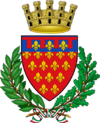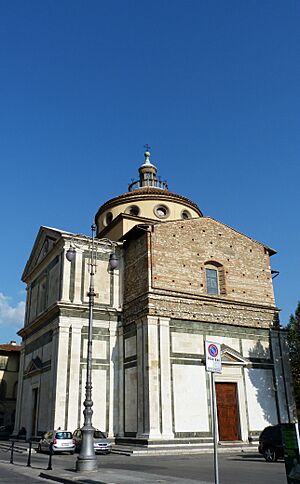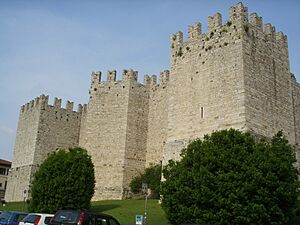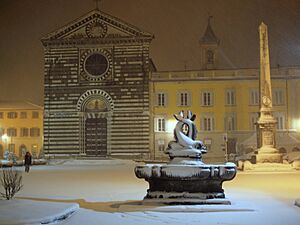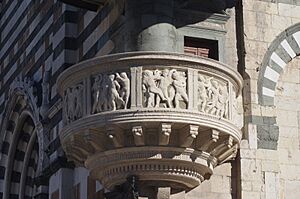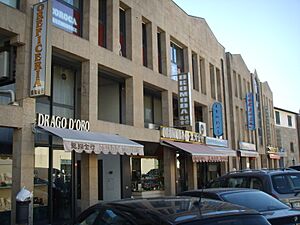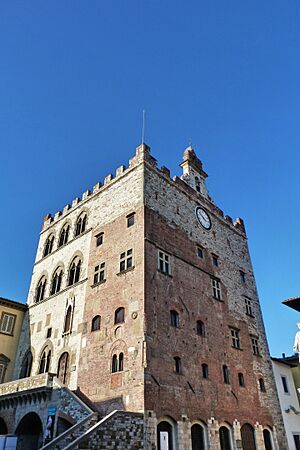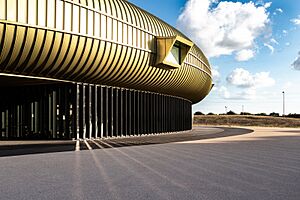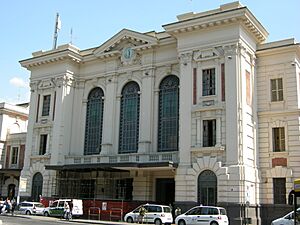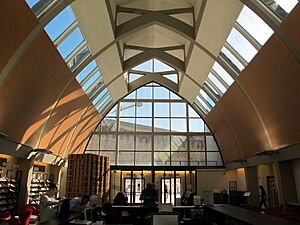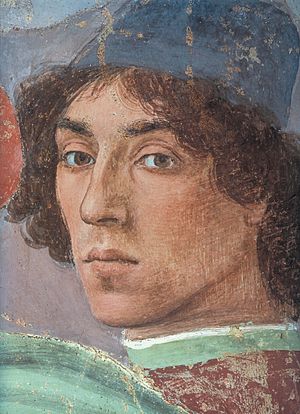Prato facts for kids
Quick facts for kids
Prato
|
|||
|---|---|---|---|
| Comune di Prato | |||
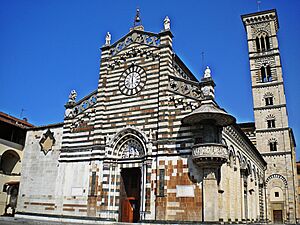 |
|||
|
|||
| Country | Italy | ||
| Region | |||
| Province | Prato (PO) | ||
| Frazioni | See list | ||
| Area | |||
| • Total | 97.35 km2 (37.59 sq mi) | ||
| Elevation | 65 m (213 ft) | ||
| Population
(1 January 2024)
|
|||
| • Total | 198,034 | ||
| • Density | 2,034.25/km2 (5,268.68/sq mi) | ||
| Demonym(s) | Pratese | ||
| Time zone | UTC+1 (CET) | ||
| • Summer (DST) | UTC+2 (CEST) | ||
| Postal code |
59100
|
||
| Dialing code | 0574 | ||
| Patron saint | St. Stephen | ||
| Saint day | 26 December | ||
Prato (/ˈprɑːtoʊ/ PRAH-toh; Italian: [ˈpraːto]) is a city in Tuscany, Italy. It is the capital of the province of Prato. The city is in northeast Tuscany, at the foot of Monte Retaia. It is about 65 meters (213 feet) above sea level.
Prato is Tuscany's second-largest city, after Florence. It is also the third-largest city in Central Italy, after Rome and Florence. As of January 1, 2024, about 198,034 people live there.
For a long time, Prato's economy has focused on making textiles. Its textile industry is the biggest in Europe. About 7,000 fashion companies are in Prato's textile area. They export goods worth about 2 billion euros. The city also has important historical and art sites. Its culture began with the Etruscans and grew through the Middle Ages. It became very important during the Renaissance. Famous artists like Donatello, Filippo Lippi, and Botticelli worked here.
Prato is also known for its cantucci. These are a type of biscotti (cookies) that were first made in Prato during the Middle Ages. Local bakers still make them today.
Contents
Exploring Prato's Past
How Prato Began
People lived in the hills around Prato since the Paleolithic (Stone Age). Later, the Etruscans settled on the plain. In 1997, a new Etruscan city was found near Gonfienti. This city was a center for the wool and textile industry. Some experts think it might have been the ancient city of Camars.
The Etruscan city was used until the 5th century BC. Then, it slowly declined. Later, the Romans took control of the area. Their Via Cassia road passed through, but they did not build a large settlement here.
Prato in the Middle Ages
In the early Middle Ages, the Byzantine and Lombard groups ruled this region. Prato's own story starts in the 10th century. There were two small villages: Borgo al Cornio and Castrum Prati (Prato's Castle). In the next century, these two villages joined together. They were ruled by the Alberti family, who were counts of Prato.
During this time, the plain was drained to create a water system. This system used water from the Bisenzio River. It helped power gualchiere, which were early textile machines. In 1107, Prato became a free commune after a siege. This meant it could govern itself.
The city grew quickly because of its textile industry. It also had the Holy Belt relic, which attracted many people. By the 13th century, Prato had 15,000 people. New city walls were built in the 12th and 14th centuries. In 1313, Prato chose to be ruled by Robert of Anjou, the King of Naples. This was to protect itself from the growing power of Florence.
However, in 1351, Joanna I of Naples sold Prato to Florence for 17,500 golden florins. After this, Prato's history was linked to Florence for many centuries.
Prato in Modern Times
In 1512, during a war, Spanish troops attacked Prato. This attack was very severe and led to Florence surrendering. It also brought the Medici family back to power in Florence. Many people lost their lives during this event.
In 1653, Prato officially became a city and got its own Catholic diocese. In the 18th century, the city became more beautiful. It also saw a lot of cultural growth. This was encouraged by the grand dukes who ruled Tuscany.
A famous person from Prato in this century was Filippo Mazzei. He was a friend of Thomas Jefferson. Mazzei's ideas are even found in the Constitution of the United States of America. He wrote the words: All men are created equal.
After Italy became one country in the 1800s, Prato became a major industrial center. It was especially known for textiles. Some even called it the "Italian Manchester" (a famous industrial city in England). The city's population grew a lot. In 1992, Prato became the capital of its own province.
Prato's Weather
Prato has a humid subtropical climate. This means it has sunny, hot summers and cool, damp winters. July is usually the driest month of the year.
Prato's Population Growth
| Historical population | ||
|---|---|---|
| Year | Pop. | ±% |
| 1861 | 32,710 | — |
| 1871 | 36,923 | +12.9% |
| 1881 | 38,985 | +5.6% |
| 1901 | 47,166 | +21.0% |
| 1911 | 51,707 | +9.6% |
| 1921 | 55,021 | +6.4% |
| 1931 | 61,496 | +11.8% |
| 1936 | 64,362 | +4.7% |
| 1951 | 77,631 | +20.6% |
| 1961 | 111,285 | +43.4% |
| 1971 | 143,232 | +28.7% |
| 1981 | 160,220 | +11.9% |
| 1991 | 165,707 | +3.4% |
| 2001 | 172,499 | +4.1% |
| 2011 | 185,456 | +7.5% |
| 2021 | 195,213 | +5.3% |
| Source: ISTAT | ||
Chinese Community in Prato
Prato has the second-largest Chinese immigrant population in Italy. The largest is in Milan. In 2008, there were about 9,927 legal Chinese residents in Prato. By 2021, this number grew to 27,829. Local officials believe the total number, including those without legal papers, might be as high as 50,000.
Most Chinese people in Prato come from Wenzhou in Zhejiang province. Some also moved from Paris. The first Chinese people arrived in Prato in the early 1990s. Many of them work in the garment industry, making clothes.
Chinatown in Prato is known as Santo Beijing. It is in the western part of the city. By 2008, over 3,100 Chinese businesses were registered. Many are in an industrial park called Macrolotto di Iolo. The Chinese textile firms have helped Prato's economy do better than other parts of Italy. Since 2019, the Chinese community has been part of local government. Two city counselors of Chinese origin were elected.
Prato's Local Dialect
The way people speak in Prato is very similar to the dialect of Florence. However, it has its own special sounds. For example, the city name "Prato" is often pronounced slightly differently by locals.
Prato's Culture and Traditions
Corteggio Storico: A Historical Parade
Every year on September 8th, Prato celebrates the Corteggio Storico. This event honors the Sacra Cintola (Holy Belt). It is held on the day of the birth of the Madonna. A parade in historical costumes goes through the city center. It includes city armies, town officials, and hundreds of people from other Italian cities.
The parade ends in Piazza del Duomo. Here, the most important part of the day happens: the Holy Belt relic is shown to everyone. The festival also has other fun activities. You can see flag-wavers and archery shows. There is a medieval market with old crafts and traditions. You can also enjoy music and fireworks.
Celebrating Chinese New Year
The Chinese groups in Prato also organize celebrations for the Chinese New Year. This follows the Lunar calendar. On the last day of the celebrations, there is a parade. It features many dragon and lion puppets. Skilled dancers and martial artists perform the traditional Dragon dance.
Palla Grossa: A Traditional Game
The game of Palla Grossa returned to Prato's Piazza Mercatale in September 2012. It had not been played for almost 30 years. Four city districts compete in this game: the Rossi (Santa Trinita), the Gialli (Santo Stefano), the Azzurri (Santa Maria), and the Verdi (San Marco).
Contemporanea Festival
The Contemporanea Festival is an international theater festival. It has been held in Prato since 1999. The event takes place at the end of May. It features important artists from the national and international modern theater scene.
Delicious Pratese Food
Prato's traditional food, like most food in Tuscany, uses simple, local ingredients. The local bread, called bozza pratese, is a key part of the cooking. In Prato, people use this bread to make dishes like croutons with livers, panzanella, and pappa al pomodoro.
Here are some typical dishes from Prato:
- Cantucci (almond biscuits)
- Bruttiboni (another type of cookie)
- Sedani ripieni alla pratese (stuffed celery)
- Mortadella di Prato (a special sausage)
- Ribollita (a hearty vegetable and bread soup)
- Torta mantovana (a sweet cake)
- Pesche di Prato (peach-shaped pastries)
- Vermouth di Prato (a local drink)
- Zuccherini (small sugar cookies)
- Bozza pratese (local bread)
Important Places to See
Prato has many museums and cultural sites. These include the Filippo Lippi frescoes in the Cathedral of Santo Stefano. These beautiful paintings were recently cleaned and restored. The cathedral also has an outdoor pulpit designed by Donatello and Michelozzo. This pulpit is used to show the famous relic of the Virgin Mary, the Girdle of Thomas (Sacra Cintola). This relic was very important in the Middle Ages.
The Teatro Metastasio is Prato's main theater. It was built in 1829–30. It hosts operas and other plays.
Palaces and Castles in the City Center
- Palazzo Pretorio: This palace started being built in the 13th century. It was made of red bricks. Later, white stone was added in the late-Gothic style. The outside staircase and clock were added in the 16th century. Today, it houses the Civic Museum of Prato.
- Palazzo Datini: This palace was built starting in 1383 for the merchant Francesco Datini. Florentine artists like Agnolo Gaddi and Niccolò Gerini decorated it. In 1409, it hosted Pope Alexander V and Louis of Anjou.
- Palazzo degli Alberti: This 13th-century palace has a museum inside. It displays art by Filippo Lippi (Madonna del Ceppo), Giovanni Bellini (Crucifix with Jew Cemetery), and Caravaggio (The Crowning with Thorns).
- Castello dell'Imperatore: This castle is in the city center. It is the northernmost castle built by Frederick II of Hohenstaufen in Italy.
Main Churches in the City Center
- Prato Cathedral: This is one of the oldest churches in Prato. It existed in the 10th century. It was built in stages in the Romanesque style. The church has many important artworks, especially sculptures.
- Santa Maria delle Carceri: Lorenzo de' Medici asked Giuliano da Sangallo to build this church in 1484. It has a Greek cross shape, inspired by Brunelleschi's Pazzi Chapel. The inside has a colorful maiolica frieze by Luca della Robbia. He also made four round artworks called tondos in the dome, showing the four Evangelists.
- Sant'Agostino: This church was built starting in 1440. It has a simple front with a rose window and a bell tower. The inside has a main area and two side areas. It contains paintings by artists like Giovanni Battista Naldini and Lorenzo Lippi. There are also 14th-century frescoes.
- San Domenico: The altars inside this church have a 14th-century crucifix and an Annunciation painting by Matteo Rosselli. The cloister (a covered walkway) of the nearby convent was built in 1478–80. A museum next to it has wall frescoes.
- San Francesco: This church holds a tomb for Geminiano Inghirami (who died in 1460). It also has frescoes by Niccolò Gerini in the beautiful Cappella Migliorati.
- San Fabiano: This church existed in 1082. It has valuable pieces of a floor mosaic from the 9th–11th centuries. The 15th-century bell tower is also notable.
- Minor Basilica of Santi Vicenzo e Caterina de' Ricci: This church is next to the San Vicenzo monastery. It was decorated for the canonization of Saint Catherine of Ricci, who is buried there.
Main Museums to Visit
- Palazzo Pretorio: This was the old city hall. It is now the Civic Museum of Prato, which reopened in 2013.
- Prato Cathedral Museum: This museum started in 1967. It grew to include items from both the Cathedral of Saint Stephen and the local church area.
- Contemporary Art Museum: This museum focuses on modern art from the last 30 years. It includes the Museum of Contemporary Art, an information center, and an education department.
- Prato textile museum: This museum and library is an important stop on the European Route of Industrial Heritage.
- Galleria di Palazzo degli Alberti: This is the art gallery of the local bank. It has famous artworks, including The Crowning with Thorns by Caravaggio.
- Museo della Deportazione: This museum remembers the victims of Nazi concentration and extermination camps.
Sports in Prato
- Rugby Club I Cavalieri Prato (Rugby team)
- A.C. Prato (Soccer team)
Getting Around Prato
Train Travel
Two railway lines cross through Prato. The Viareggio-Florence Railroad connects Prato with Florence and western Tuscany. The Bologna-Florence Railways is a major Italian railway line. This means Prato is served by some long-distance trains.
There are three train stations in the city:
- Prato Porta al Serraglio railway station is in the historical center. You can reach Florence in about 25 minutes from here.
- Prato Centrale railway station opened in 1862. It is the largest station in Prato.
- Prato Borgonuovo Station
Highways
- Motorway A11 (Firenze-Mare): Prato can be reached by this motorway at Prato Est and Prato Ovest exits.
- Motorway A1 (Milano-Napoli): Prato is also served by this motorway at the Calenzano exit.
Bus Services
Buses in Prato are managed by Autolinee Toscane since November 1, 2021. There are 11 active bus routes. Five of these are LAM routes (LAM Blu, LAM Rossa, LAM Arancio, LAM Viola, LAM-MT). These routes connect the city center, nearby areas, and suburbs. Buses run every 7 to 15 minutes.
Learning and Education
Prato has a University Campus, which is part of the University of Florence. It also has the Prato Research Foundation. This includes the Istituto Geofisico Toscano and a Research Center.
Universities in Prato
Since the early 1990s, Prato has been home to an important university center. It is called the "University Campus of Prato." Over 2,000 students are enrolled here. It is a partnership between the University of Florence and local groups. The campus offers courses in economics, humanities, engineering, medicine, and political sciences.
International Universities
Several international universities have a presence in Prato:
- Monash University from Australia opened an office in Palazzo Vai in 2001.
- University of New Haven from the U.S. opened a satellite campus in 2012.
- Beacon College from the U.S. started a study abroad program in Prato in 2017.
High Schools in Prato
Prato has many high schools, including:
- Cosimo Bellini Institutes
- Conservatory of San Niccolò
- Cicognini, State National Boarding School
- Liceo Scientifico / Linguistico Statale "Carlo Livi"
- Liceo Scientifico / Linguistico Statale "Niccolò Copernico"
- Liceo Artistico Statale "Umberto Brunelleschi"
- "F. Cicognini" Classical High School
- Liceo Socio Psycho-pedagogical and Social Sciences "Gianni Rodari"
- State Institute of Higher Education "A. Gramsci – J.M. Keynes"
- Tullio Buzzi State Technical Industrial Institute
- Paolo Dagomari State Technical Commercial Institute
- Istituto Tecnico Agrario e Professionale Alberghiero di Stato "Francesco Datini"
- State Professional Institute for Industry and Crafts
Famous People from Prato
Many notable people were born in or lived in Prato:
- Nicolò Albertini, 13th-century cardinal
- Lorenzo Bartolini, sculptor
- Sem Benelli, writer
- Roberto Benigni, actor and director
- Francesca Bertini, actress
- Antonio Brunelli, composer
- Clara Calamai, actress
- Ferdinando Castagnoli, archaeologist
- Jury Chechi, gymnast, Olympic gold medalist
- Compagnetto da Prato, medieval poet
- Enrico Coveri, fashion designer
- Lorenzo Dalla Porta, motorcycle racer
- Francesco Datini, 14th-century merchant
- Alessandro Diamanti, soccer player
- Emilia Goggi, opera singer
- Filippino Lippi, 15th-century painter
- Fiorenzo Magni, cyclist
- Curzio Malaparte, writer
- Filippo Mazzei, politician
- Giovanni Nesi, pianist
- Francesco Nuti, actor
- Iva Pacetti, opera singer
- Gianni Pedrizzetti, engineer and professor
- Rachele Risaliti, Miss Italia 2016
- Paolo Rossi, soccer player
- Christian Vieri, soccer player
- Pamela Villoresi, actress
- Domenico Zipoli, composer
Prato's Sister Cities
Prato is twinned with several cities around the world:
 Albemarle County, U.S. (since 1977)
Albemarle County, U.S. (since 1977) Bir Lehlou, Western Sahara (since 1985)
Bir Lehlou, Western Sahara (since 1985) Changzhou, China (since 1987)
Changzhou, China (since 1987) Ebensee am Traunsee, Austria (since 1987)
Ebensee am Traunsee, Austria (since 1987) Nam Dinh, Vietnam (since 1975)
Nam Dinh, Vietnam (since 1975) Roubaix, France (since 1981)
Roubaix, France (since 1981) Sarajevo, Bosnia and Herzegovina (since 1997)
Sarajevo, Bosnia and Herzegovina (since 1997) Wangen im Allgäu, Germany (since 1988)
Wangen im Allgäu, Germany (since 1988)
Images for kids
See also
 In Spanish: Prato (Toscana) para niños
In Spanish: Prato (Toscana) para niños



